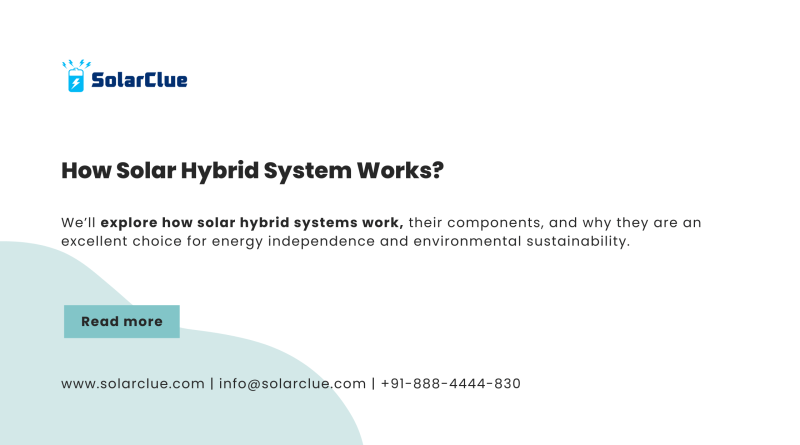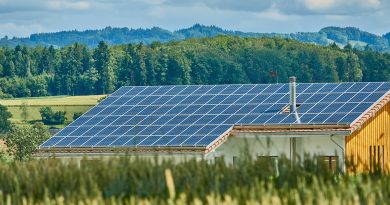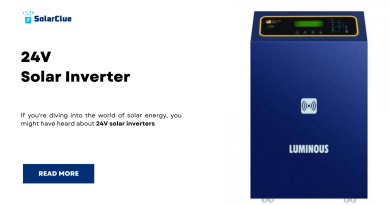How Solar Hybrid System Works?
As the world increasingly shifts toward sustainable energy solutions, solar hybrid systems have emerged as a popular choice for both residential and commercial applications. These systems combine the benefits of solar power with the reliability of traditional electricity grids, providing a seamless and efficient energy solution. In this blog, we’ll explore how solar hybrid systems work, their components, and why they are an excellent choice for energy independence and environmental sustainability.
Table of Contents
Components of a Solar Hybrid System
Solar Panels:
Solar panels are the primary component of a solar hybrid system, converting sunlight into electricity. They are typically mounted on rooftops or open areas to capture maximum sunlight.
Battery Storage:
Batteries in a solar hybrid system store excess energy generated during the day. This stored energy can be used at night or during periods of low sunlight, ensuring a continuous power supply.
Inverter:
The inverter is crucial in converting the direct current (DC) produced by the solar panels and stored in the batteries into alternating current (AC), which is used by household appliances.
Working Principle of Solar Hybrid System
1. Solar Panels Generate Electricity from Sunlight:
The process begins with the solar panels absorbing sunlight and converting it into electrical energy. The photovoltaic cells within the panels capture photons from the sun, initiating a flow of electrons that generates DC electricity. The amount of energy produced depends on factors such as the type of panels, sunlight intensity, and the efficiency of the solar hybrid system.
2. Excess Energy is Stored in Batteries for Later Use:
One of the standout features of a solar hybrid system is its ability to store excess energy. During peak sunlight hours, the energy generated by the solar panels may exceed the immediate consumption needs of the household or business. Instead of letting this excess energy go to waste, it is stored in batteries. This stored energy becomes invaluable during the night, cloudy days, or during power outages, providing a reliable backup power source.
3. Inverter Converts DC Power from Batteries to AC Power for Use in Household Appliances:
The stored energy in the batteries is in the form of DC power, which most household appliances cannot use directly. This is where the inverter comes into play. The inverter converts the DC power into AC power, making it compatible with the electrical appliances in your home or business. Additionally, if the energy demand exceeds the solar production and stored battery energy, the system can draw power from the grid, ensuring an uninterrupted power supply.
Advantages of Solar Hybrid Systems
Reduced Electricity Bills: By utilizing solar energy and stored battery power, reliance on grid electricity is significantly reduced, leading to lower electricity bills.
Environmentally Friendly: Solar hybrid systems help reduce carbon emissions by harnessing renewable energy from the sun, contributing to a cleaner environment.
Energy Independence: With the ability to store energy and use it during grid outages, solar hybrid systems provide a level of energy independence that is unmatched by traditional power systems.
Applications of Solar Hybrid Systems
Residential Buildings: Ideal for homeowners looking to reduce energy costs and ensure a reliable power supply during outages.
Commercial Establishments: Businesses can benefit from reduced operational costs and enhanced sustainability by integrating solar hybrid systems.
Remote Locations: In areas with unreliable or no grid access, solar hybrid systems provide a dependable and cost-effective energy solution.
Conclusion
In summary, solar hybrid systems work by generating electricity from sunlight, storing excess energy in batteries, and converting this stored energy into usable power for household or business use. Their ability to reduce electricity bills, promote environmental sustainability, and provide energy independence makes them a compelling option for anyone looking to adopt renewable energy solutions. As the world moves toward greener energy sources, installing a solar hybrid system is a proactive step toward a sustainable future.
Key Components and Functions of a Solar Hybrid System
| Component | Function | Key Benefits |
|---|---|---|
| Solar Panels | Convert sunlight into electrical energy | Generates clean, renewable energy |
| Battery Storage | Store excess energy for later use | Provides backup power during outages |
| Inverter | Convert DC power to AC power for household use | Ensures compatibility with household appliances |
Ready to see how a solar hybrid system can transform your energy usage? Understanding how it works is the first step toward greater energy independence and savings. Visit SolarClue to explore our range of hybrid solar solutions and get expert guidance on making the switch. With SolarClue, you can harness the power of the sun and enjoy a reliable, efficient energy system tailored to your needs. Start your journey towards smarter energy today!




